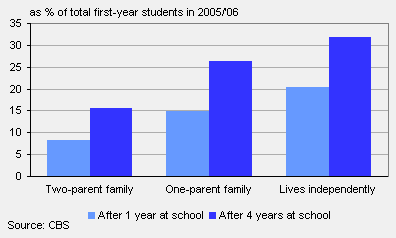Nearly one in five first-year mbo students leave school without a diploma

Drop-out rates in senior secondary vocational education (mbo) range from 10 percent after one year in school to nearly 20 percent after four years. Students in the lowest level of mbo and those from one-parent families have the greatest risk of leaving school without a diploma.
High drop-out rates in lowest level of mbo
Ten percent of the first-year mbo students in 2005/’06 had left school without a diploma one year later. Four years later, this was 18 percent. Drop-out rates are particularly high in the lowest level of mbo, assistant training: 21 percent after one year and 28 percent after four years. At the highest level, level 4, drop-out rates were considerably lower ((8 percent after one year and 15 percent after four years).
Drop-out rates in mbo by level, first-year students in 2005/’06

More drop-outs in one-parent families
Fifteen percent of first-year mbo students in 2005/’06 who grow up in one-parent families had dropped out of school one year later, 26 percent four years later. These rates are higher than those for children in two-parent families ((8 percent and 16 percent respectively). The higher rates for students in one-parent families were observed in all levels of mbo.
The highest drop-out rates were observed for students who had left home ((20 percent after one year and 32 percent after 4 years). This group is small however: onlyy 3 percent of first year mbo students in 2005/’06 lived away from their parents.
Drop-out rates in mbo by family type, first-year students in 2005/’06

Kasper van der Heide